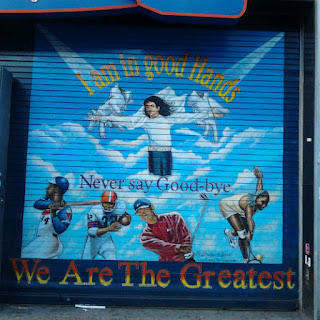Readers yesterday were momentarily concerned by my advocacy of some genre fiction. Has The Jade Sphinx abandoned high artistic ideals? Is junk now art?
Well, no. My point is simply that sometimes the keenest satisfaction is to be found in art in its humblest forms. However – that does not change the fundamental proposition that there is good art and there is bad art. And also that -- somewhat lower in stature than bad art -- we find much of graffiti and street art.
This brings us to a quick look at Harlem, New York celebrity Franco the Great. Self promotion does not seem to be a problem for Franco the Great – if you don’t think he’s great, he’ll be the first to correct you. A quick look at his Web site reveals his own tagline, Franco the Great. Known as Harlem’s Picasso. Artist Extraordinaire.
Franco Gaskins was born in Panama. After a rather tragic accident in his youth (he fell on his head), he became an amateur magician while maintaining an interest in the arts. He came to the United States at the urging of his grandmother in 1958, where he established himself in New York as muralist. Since the 1960s, Franco has been painting pictures on the iron security gates that protect many Harlem storefronts at night. His images are often of celebrities (Mr. T, Michael Jackson, various basketball players), or turgid representations of angels, heaven or some other syrupy strain of mysticism.
There is very little that can be said of Franco’s art that hasn’t already been said about the work of the child or younger relation adorning your refrigerator: it’s not actually good, but if you like that sort of thing, that’s the sort of thing you like. To my eye, his lack of composition, unsteady anatomy, bad coloration, parochial worldview and vapid technique does not make him a master of folk art; rather, it makes him a practitioner of something much more insidious: non-art.
Non-art is the sort of thing that vandals scrawled all over subway cars and on the sides of abandoned buildings throughout the 1970s. Non-art is often a crypto-criminal act, a defacement making a political statement or a desperate cry to improve self-esteem. Non-art is forging an identity at someone else’s expense; usually made by the artistically and intellectually unengaged. Non-art is the repulsive “community projects” erected by amateur artists for tasteless bureaucrats as a sop to the aesthetically impoverished.
Harlem is also the site of another wonderful example of non-art: the mural on the side wall of the Adam Clayton Powell Plaza at West 125th Street and Adam Clayton Powell Blvd. By no aesthetic yardstick could this be called good work (see below); but it does seem to draw both tourists and locals. One amusing trick learned in long contemplation of this work is how to tell tourists from Harlem natives: tourists pose in front of it for photos, residents stand in front of it to urinate. (My New York readers are welcome to visit the site themselves lest I be accused of yellow journalism.)
Many of Franco’s security-gate murals would have been mercifully removed by a new city law concerning gates; however, his works have been preserved for removal to an outside art gallery at the East River. One can only hope the critics there don’t stream in so regularly as those at Adam Clayton Powell Plaza.
Non-Art and Public Restroom
at Adam Clayton Powell Plaza


No comments:
Post a Comment